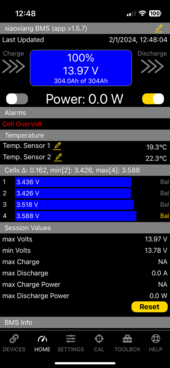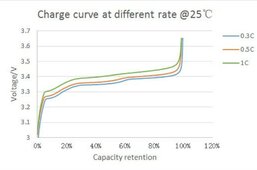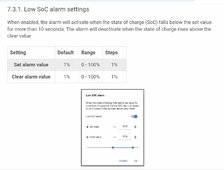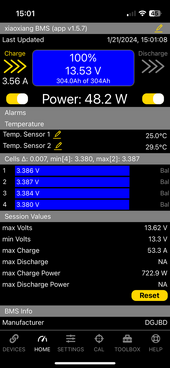You are using an out of date browser. It may not display this or other websites correctly.
You should upgrade or use an alternative browser.
You should upgrade or use an alternative browser.
Are these values normal?
- Thread starter Iridetheshortbus
- Start date
Iridetheshortbus
New Member
I wasn’t aware I needed charge more. Good to know. So if I’m pushing 30amps into the battery it will automatically limit it lower when fully charged?Looks OK but you need to charge to at least 14V max volts and hold there until current falls to 0.05C or 15A. Your battery is not fully charged.
BentleyJ
Solar Wizard
Yes, its called tail current. When the cells reach full charge at 3.5V per cell (14.0V) The potential of the cell itself resists the flow of current and amperage drops off rather sharply. This how charge controllers know when to switch over from Absorption mode (constant voltage charging) to No Charge or Float depending on the selection of 2 or 3 stage charging.So if I’m pushing 30amps into the battery it will automatically limit it lower when fully charged?
KITROBASKIN
Solar Enthusiast
Thinking we need more information.
Some people here have no problem with your charge settings. How did you come about choosing those values?
Some people here have no problem with your charge settings. How did you come about choosing those values?
Iridetheshortbus
New Member
Choose? Those are the values that the battery’s displaying while charging. I didn’t choose them they are a byproduct.Thinking we need more information.
Some people here have no problem with your charge settings. How did you come about choosing those values?
Last edited:
rodrick
Free energy enthusiast
Don’t rely on the bms state of charge displayed it is about as accurate as the weather forecast to truly know what the charge level is you need to install a shunt
Iridetheshortbus
New Member
Yea I definitely know not to blindly trust the bms soc anymore, Can you recommend any shunts? A wireless connection is preferred.Don’t rely on the bms state of charge displayed it is about as accurate as the weather forecast to truly know what the charge level is you need to install a shunt
I assume I’d attached the shunt between the battery positive and positive bus bar?
rodrick
Free energy enthusiast
Victron smart shunt about $130 Bluetooth and ve direct ready I have 3 personally and love themYea I definitely know not to blindly trust the bms soc anymore, Can you recommend any shunts? A wireless connection is preferred.
I assume I’d attached the shunt between the battery positive and positive bus bar?
What was the state of charge displayed and cell voltages just before cut off? Heavy load?Yea I definitely know not to blindly trust the bms soc anymore,
Iridetheshortbus
New Member
Happened over night, so can’t be certain. Everything looked normal at 8/9pm with over 100amps left on the battery but at 6 am the battery was dead. I know from 12am-6 the only draw on the battery would have been a heater pulling at max 4-5amps.What was the state of charge displayed and cell voltages just before cut off? Heavy load?
My best guess is that the 15-20amps I was using during the day for a long period had yet to be fully reflected on the bms soc
Since recharging to 100% I’ve had no issues.
I wish I could have my overkill solar bms send me a notification when I reach a certain percentage or amp/hrs remaining.
What kind of heater only takes 4-5 amps DC? More likely, it's 4-5 amps @ 120VAC, which is 37.5-47 amps @ 12.8VDC.Happened over night, so can’t be certain. Everything looked normal at 8/9pm with over 100amps left on the battery but at 6 am the battery was dead. I know from 12am-6 the only draw on the battery would have been a heater pulling at max 4-5amps.
My best guess is that the 15-20amps I was using during the day for a long period had yet to be fully reflected on the bms soc
Since recharging to 100% I’ve had no issues.
I wish I could have my overkill solar bms send me a notification when I reach a certain percentage or amp/hrs remaining.
Iridetheshortbus
New Member
A diesel heater uses that much power and it’s only 4-5 amps with the fan blowing full, most the time it’s 1-2amps.What kind of heater only takes 4-5 amps DC? More likely, it's 4-5 amps @ 120VAC, which is 37.5-47 amps @ 12.8VDC.
In the end more capacity is needed. Although if the BMS indicated more charge remaining than it had it may have implied skipping the evening recharge was OK. Honestly I would spend the monitor money on a second battery.
Maybe keep closer tabs on voltage etc to verify the charge level as the evening progresses and what is left in the morning.
Maybe keep closer tabs on voltage etc to verify the charge level as the evening progresses and what is left in the morning.
Last edited:
Iridetheshortbus
New Member
This was an only a one time thing I rarely run my battery so close to empty. Was stuck in single digit weather for a couple days.In the end more capacity is needed. Although if the BMS indicated more charge remaining than it had it may have implied skipping the evening recharge was OK. Honestly I would spend the monitor money on a second battery.
Maybe keep closer tabs on voltage etc to verify the charge level as the evening progresses and what is left in the
Definitely have made it a bed time routine to check the battery levels.
Iridetheshortbus
New Member
Here’s an update, I’ve been letting the battery fully charge and one of my cells is off from the others. Should I look into do a top balancing?Yes, its called tail current. When the cells reach full charge at 3.5V per cell (14.0V) The potential of the cell itself resists the flow of current and amperage drops off rather sharply. This how charge controllers know when to switch over from Absorption mode (constant voltage charging) to No Charge or Float depending on the selection of 2 or 3 stage charging.

BentleyJ
Solar Wizard
162mV Delta, yes its time to top balance or add a 2A to 5A active balancer.
Iridetheshortbus
New Member
So I currently don’t have a power supply so would you suggest getting one to top balance or would the active balance be the better route?162mV Delta, yes its time to top balance or add a 2A to 5A active balancer.
BentleyJ
Solar Wizard
Cell #4 is high but the voltage didn't run away and trigger an over voltage alarm which is a more serious situation so I wouldn't recommend getting a separate power supply. A separate active balancer is the way to go because it will keep things in line at every charge cycle.So I currently don’t have a power supply so would you suggest getting one to top balance or would the active balance be the better route?
Is important to select a model with a Voltage based trigger that can be set at 3.4V. The balancer should only be active when the first cell hits 3.4V.
I'm using a JK-BMS brand active Bluetooth balancer but it doesn't have the above feature. Maybe the new models do? Funny thing is their BMS's with balancing built-in does have the feature.
Andy at Off-Grid Garage has posted MANY BMS and balancer YT videos if want to do some research. If the newer JK brand 2A balancer doesn't have the feature maybe try Neey. Sorry, I'm not up to date on all the choices at the moment.
Iridetheshortbus
New Member
Thanks for the information, just to clarify I meant getting a power supply to perform a top balancing.Cell #4 is high but the voltage didn't run away and trigger an over voltage alarm which is a more serious situation so I wouldn't recommend getting a separate power supply. A separate active balancer is the way to go because it will keep things in line at every charge cycle.
Is important to select a model with a Voltage based trigger that can be set at 3.4V. The balancer should only be active when the first cell hits 3.4V.
I'm using a JK-BMS brand active Bluetooth balancer but it doesn't have the above feature. Maybe the new models do? Funny thing is their BMS's with balancing built-in does have the feature.
Andy at Off-Grid Garage has posted MANY BMS and balancer YT videos if want to do some research. If the newer JK brand 2A balancer doesn't have the feature maybe try Neey. Sorry, I'm not up to date on all the choices at the moment.
BentleyJ
Solar Wizard
Yes, I was just making the point that a bench top power supply is a manual process where its connected once every few months to top balance then removed. An active balancer is installed permanently, much less trouble.
Iridetheshortbus
New Member
People top balance more than once? I should mention I didn’t top balance when I originally got my battery’s they seemed close enough. My bms (overkill solar) performs some balancing but I’m assuming an active balancer does more?Yes, I was just making the point that a bench top power supply is a manual process where its connected once every few months to top balance then removed. An active balancer is installed permanently, much less trouble.
BentleyJ
Solar Wizard
I believe Overkill uses Passive balancing which means resistors are used to reduce the voltage of high cell(s). Basically wasting energy as heat so the amount of current has to be very low, Like 100 to 200mA. Would take a long time to balance the cells.
Active balancing removes energy from the high cell, either with capacitors or inductors, then injects the energy into the low cell. This type can be 1A to 15A. Much more efficient and doesn't produce excess heat. (although that would be desirable in a cold climate) Recommended at least 1A of balancing current for each 100Ah of battery capacity.
Active balancing removes energy from the high cell, either with capacitors or inductors, then injects the energy into the low cell. This type can be 1A to 15A. Much more efficient and doesn't produce excess heat. (although that would be desirable in a cold climate) Recommended at least 1A of balancing current for each 100Ah of battery capacity.
mikefitz
Solar Wizard
- Joined
- May 28, 2020
- Messages
- 3,161
Looks normal, the battery is still accepting a small charge current.charging fully today these are my values. Should the cell voltage be higher?
30 amps into a 300Ah battery , (charging at 0.1 C), will have achieved full charge by the time the battery reaches 14.0 volts. Note the graph shows cell volts under charge , with a low charge current full charge is reached as the cell approaches 3.5 volts, 14.0 for a 4 cell battery. Once the charge voltage is removed the battery volts will be in the region of 13.4 volts at rest.if I’m pushing 30amps into the battery

No, the shunt connects between battery negative and negative buss bar, recommend Victron Smart shunt, or the Victron BMV712.assume I’d attached the shunt between the battery positive and positive bus bar?

The battery reached 13.97 volts and all the cells exceeded 3.4 volts, that's a full battery. If you lower the charge voltage to 13.90 volts or slightly lower, with a long absorbtion period, the cells will better balance over time with the BMS balancer. It's not critical, so carry on using the battery as normal.my cells is off from the others. Should I look into do a top balancing?
The Victron BMV712 shunt with programmable internal relay could activate an alarm at a SOC or voltage level.a notification when I reach a certain percentage or amp/hrs remaining

Personally I am not a fan of active balance circuits but if added should perform better than the BMS. Your battery inbalance is not too serious and is typical of ready built battery, (I know yours is diy). With suitable charge voltages and extended absorbtion, your BMS should have an effect. It's worth trying for a few weeks before taking alternative action.didn’t top balance when I originally got my battery’s they seemed close enough. My bms (overkill solar) performs some balancing but I’m assuming an active balancer does more?
I think you have a Renogy Rover solar controller, its default setting for lithium is not ideal. I suggest user setting a charge and float voltage of 13.8 volts, try this for a week or two and see if the balance improves.
Mike
Similar threads
- Replies
- 17
- Views
- 451
- Replies
- 18
- Views
- 840
- Replies
- 6
- Views
- 591
- Replies
- 23
- Views
- 1K



